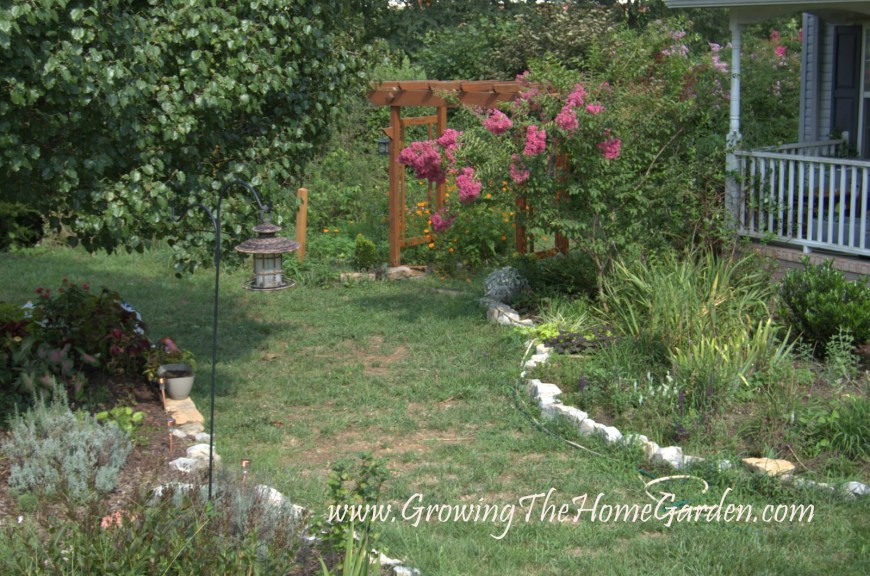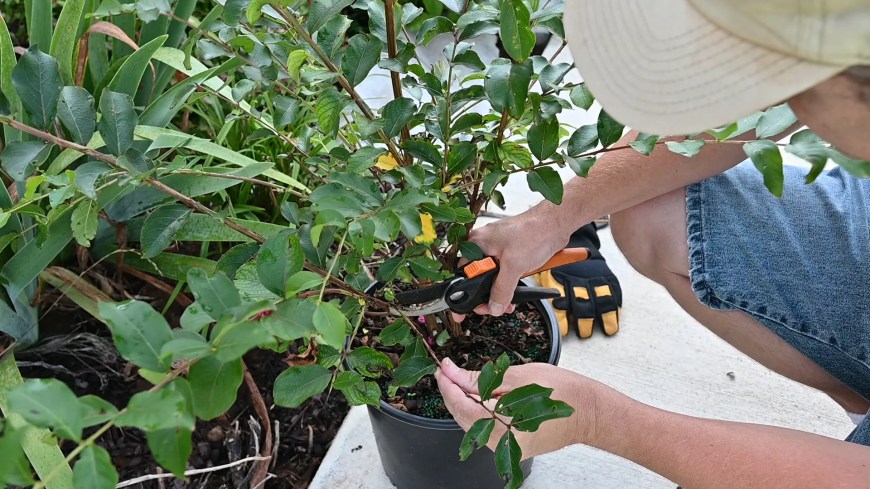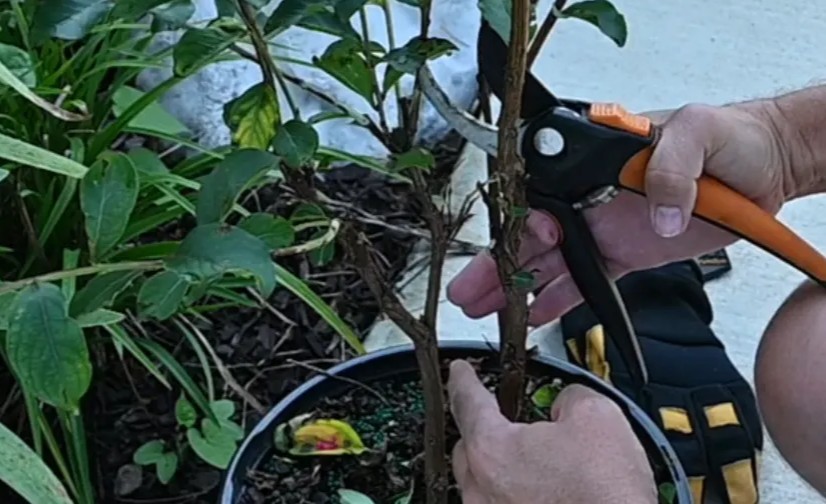Recently I came across a crape myrtle on sale and decided to add it to our front garden. It’s a variety called ‘Tuscarora’ that can reach about 15 feet wide and up to 20 feet tall. There are a wide variety of crape myrtle trees available but ‘Tuscarora’ produces beautiful reddish-pink, almost watermelon-colored blooms. It’s very similar to a tree we had at our old house that I grew into a tree form crape myrtle.

Don’t Commit Crape Murder!
Unfortunately, crape myrtles are often victims of “crape murder,” where people cut off the tops of the trees. This leaves the trees looking knobby, almost like a clenched fist with all the fingers chopped off. We’re going to avoid that and get this tree started right by shaping it early.
Before Your Start Pruning
Before doing any pruning, take time to examine the plant and plan. Looking at the base of this one, I see two main trunks emerging from the pot. These are the shoots I’ll likely keep. Ideally, for a multi-stemmed crape myrtle, you want to choose between three and five strong leaders. Some people go with just a single trunk to make it into an elegant single stemmed tree. Also, in the nursery industry, it’s common for growers to stick multiple cuttings into one pot, so it’s possible we’re dealing with more than one plant.

Save the Pruned Branches for Crape Myrtle Propagation
As I prune the crape myrtle, I’m saving the healthy green material for propagation. These side shoots make great cuttings, so as I prune I put the branches in a bucket of water to root later. (I ended up with about 16 cuttings from this one session, which I’ll track in a future video/post.)
For Pruning all I needed was a pair of hand pruners. My pruners are like these from Fiskars (aff.)
Pruning the Crape Myrtle
When pruning, pay close attention to the direction of the branches. You want to avoid crossing branches that grow into each other. Crossed branches can cause issues with rubbing through the cambium layer of bark and introduce other disease issues. Plus by removing crossed branches you allow the tree to retain a cleaner appearance overall.
I removed several that crossed or were growing too low. One branch had a Y shape with potential for a good structure, so I may keep that one and decide later in winter after observing how it grows.

The goal is to create an open structure, which helps reduce fungal issues and encourages that classic exfoliating bark. The knobby spots from cuts will eventually disappear as the trunks thicken.
After pruning, I planted the tree and watered the plant in (despite the rain) because I wanted to make sure the soil settled around the roots without large air pockets. When putting the mulch back over the tree area I was careful not to create a “mulch volcano” by covering the crown of the plant.
It needed a little extra help
To help shape the crape myrtle, I used a small block of wood I’ve saved just for this purpose. (not really, I must have a few hundred little blocks of wood somewhere) The block of wood will help spread branches slightly so the canopy will open up. Some branches may need additional support or light staking to ensure proper form as they mature.
Future Pruning Tips
Now that it’s planted, we’ll maintain the tree shape by removing any new side shoots or suckers that come from the base unless we decide to allow more trunks to form. We’ll keep the leaders growing straight until they reach about 5 to 6 feet tall, then we can top them slightly to encourage lateral branching. I’ll only allow the branches to grow where I want them and keep maintaining a clean trunk and root crown area.
Crape Myrtle Dieback Issues in Colder Areas
If you’re in a colder climate and your crape myrtle dies back, it may regrow from the base. You can retrain it as a tree if needed. However, if you’re trying to remove a crape myrtle permanently, you may need to treat the stump with chemicals to prevent regrowth. When/if roots send up shoots away from the tree, those can either be propagated or pruned back.
How it Fits in Our Garden
This ‘Tuscarora’ is going into a full-sun garden with coleus, rudbeckia, daylilies like ‘Primal Scream,’ coneflowers, and Clara Curtis mums. Eventually, the crape myrtle will create some shade, and I may need to relocate some sun-loving plants. I expect our tree to grow about 2 feet per year, possibly more since we’re limiting the number of shoots and focusing the plant’s energy.
Pruning Guide to Grow a Tree Form Crape Myrtle
- Examine and plan first. Look at the base of the plant and decide how many main trunks you want to keep (typically 1 to 5).
- Select strong leaders. Choose your main trunks (or leaders) to keep and remove excess ones.
- Remove low and side shoots. Cut off growth at the base and lower part of the trunk to begin shaping.
- Watch for crossing branches. Eliminate any branches that cross or rub against each other to avoid structural problems.
- Shape the canopy. Use small braces or guides to help young branches grow outward and upward into an open structure.
- Save healthy cuttings. Keep green, healthy side shoots for propagation if desired.
- Water in the tree. After planting and pruning, water to settle the soil and remove air pockets around the roots.
- Avoid mulch volcanoes. Keep mulch away from the crown of the tree to prevent rot.
- Maintain the form. As the tree grows, continue removing suckers and side growth, and correct shape as needed.
- Top leaders when tall enough. Once trunks are about 5–6 feet tall, lightly top them to encourage lateral branching at canopy height.
- Adjust over time. Revisit in winter to refine structure when the tree is dormant.
The Tuscarora crape myrtle (Lagerstroemia indica × fauriei ‘Tuscarora’) was developed by Dr. Donald Egolf at the U.S. National Arboretum in the 1970s as part of a breeding program to create crape myrtles with improved cold hardiness, disease resistance, and ornamental value. It is a hybrid between Lagerstroemia indica, originally from China, and Lagerstroemia fauriei, native to Japan. Named after the Tuscarora Native American tribe, this cultivar is one of several in the series known for vibrant flowers and strong landscape performance.
Tuscarora Crape Myrtle – Growing Info
- Botanical Name: Lagerstroemia indica × fauriei ‘Tuscarora’
- Flower Color: Coral-pink to watermelon red
- Bloom Time: Midsummer to early fall (long-lasting blooms)
- Mature Size: 15–20 ft tall × 12–15 ft wide
- Form: Upright, multi-stemmed small tree or large shrub
- Light Requirements: Full sun (6+ hours for best flowering)
- Soil Requirements: Well-drained soil; tolerates clay, loam, or sandy soils
- Water Needs: Moderate once established; drought tolerant
- Growth Rate: Fast (up to 2 feet/year in ideal conditions)
- Bark: Exfoliating with smooth cinnamon-tan bark
- Hardiness Zones: USDA Zones 7–9
- Pest/Disease Resistance: High resistance to powdery mildew
- Landscape Use: Accent tree, street tree, or foundation planting
- Patent: No Current Patent
Rooting Heuchera through Cuttings
You know how I am, if I grow it I see if I can root it! The challenge this time was to root a heuchera from a leaf cutting. It isn’t difficult if you take from the right part of the plant. Just taking a…
Wildflowers Blooming in September
Welcome to my bone dry September garden for Wildflower Wednesday! We have an assortment of fall blooming flower pictures to share. You really don’t need a reason other than their beauty to plant wildflowers but the fact that so many of them require little to…
Asiatic Lily Propagation with Bulbils
Perhaps one of the easiest methods of plant propagation is through bulbils. Bulbils are simply baby plants produced along aerial stem of a plant. Lilies are well known for producing bulbils and you can take advantage of this natural plant ability to create more lilies…
Gardening With Children
I often heard stories from people about their gardening experience when they were children. Usually the story has something to do with the person being forced to pull mountains of weeds. The quickest way for kids to lose their interest in gardening is to force…
Herb Garden Layout (A Corridor Pathway)
Here’s another idea I had for my herb garden. I’ve been planning my vegetable garden with a shrub/perennial ring around it. This herb corridor would lead up to a small entry gate going into the garden area. The beginning of the corridor would start close…
Designing the Winter Garden: An Asymmetrical Plan
Here is the second of the two hand drawn sketches of my winter garden layout. The first one was symmetrical. This layout uses mostly the same plants just puts them in different places. One addition to this plan is a miscanthus that I originally planted…
Discover more from Growing The Home Garden
Subscribe to get the latest posts sent to your email.







